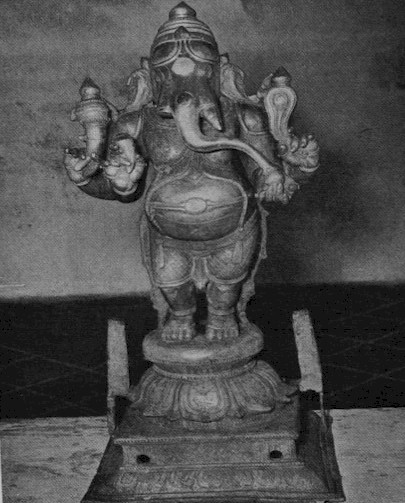The Indian system of beliefs venerates Ganesha
the elephant faced God as a destroyer of obstacles and the source of good luck. Ganesha
or Vinayaka is one of the most popularly worshipped deities in the Indian
system of beliefs and practices.

Ganesha is revered as the son of the Universal parents Shiva and Parvati, and
is always honored first in most worship services and rituals. Ganesha is also known as Ganapati,
Vigneswara, Vinayaka, Gajamukha and Ainkaran.
Symbolism: The huge size of Ganapati
represents the Universe (Cosmos), and his curled trunk, the symbol OM.
The elephant's head is said to represent superior intellect while the snake around his
waist cosmic energy. His broken tusk is symbolic of knowledge, as it is believed that it
is with this tusk that he wrote down the Mahabharata, in the capacity of
a scribe, when it was recited by the sage Vyasa. The mouse - mooshikam,
his mount is said to symbolize the equal importance of the biggest and smallest of
creatures, in the eyes of the infinity of creation Bhraman.
Ganesha is believed to have been the scribe who wrote
down the text of the Indian epic Mahabharatam as it was recited by the
sage Vyasa.
The Ganesa Pancharatnam of Aadi
Sankaracharya in sanskrit salutes Ganapati. The tamil works of Tirumoolar
and Avvaiyaar (of the 1st millennium CE), also bear hymns saluting
Ganesha. So do the Tiruppugazh hymns of Arunagirinathar
of the 1st half of the 2nd millennium CE. Several of the sanskrit kritis of the Karnatic
Music composer Mutthuswamy Deekshitar salute Ganapati shrines all over
Tamilnadu.
Several small temples dedicated to Ganapati
adorn all towns and villages of south India. Most of these are modern temples. There are
several shrines to Ganesha in all Saivite temples all over south India.
Ganesha is taken out at the head of all processions in festivals celebrated in the Saivite temples of Tamilnadu.
Vinayaka Chaturti
is a festival celebrated in honor of Ganesha, and it is celebrated as a community
festival in the state of Maharashtra, where Vinayak is held in great reverence, especially
in the 8 Ashta Vinayak temples in the vicinity of Pune and in the Siddhi Vinayak temple in
Mumbai.
Perhaps the most ancient
of Ganapati shrines in India, is the well known Karpaka Vinayakar temple in the
town of Pillaiarpatti near Karaikkudi in Tamilnadu. This temple with a
rock cut shrine, bearing a collossal form of Vinayakar, is over
1600 years old.
The Ucchi
Pillaiyaar temple, on top of a hill defining Tiruchirappalli's (Tamilnadu)
skyline, enshrines Ganapati, who is said to have been instrumental in
enshrining Ranganathar at Srirangam
nearby.
Ganapateeswaram,
enshrining Uttarapateeswarar and Vatapi Ganapati has been revered by the Tevaram hymns of the 1st millennium CE.
It is closely associated with the Pallavas of Tamilnadu, and it bears an
image of Ganapati brought back by the Pallavas from Badami
in Deccan.
Tiruvalanchuzhi
near Kumbhakonam is a Saivite
temple venerated by the Tevaram hymns
of the 1st millennium CE. It is known better for its shrine to Vinayakar,
said to have been fashioned out of foam. Nearby is the Skandastalam Swamimalai.

